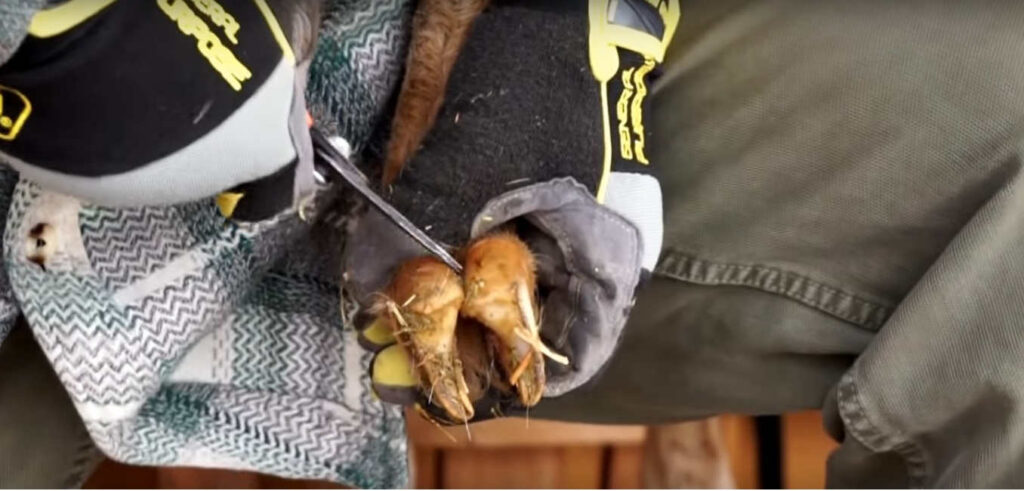--- Blog, Backyard goats, Pasture Life
Hoof Rot in Goats
Treating Hoof Rot in Goats
Hoof Rot is a contagious bacterial infection of the hooves of goats and other ruminant species. Contracting hoof rot is most common in wet conditions where pastures accumulate mud and manure. The bacteria that cause this disease are often carried in the fecal matter of goats and other ruminants like sheep. However, infection only takes place through open wounds or irritations in goats’ hooves.
Contributing Factors to Hoof Rot Predisposition
Certain factors can predispose goats to hoof rot such as untrimmed hooves or zinc deficiency. Leaving hooves untrimmed highly exacerbates the chance for infection by trapping bacteria and moisture in the foot. This essentially causes a ‘trench-foot’ condition. Regularly checking and trimming hooves is essential for the prevention and early defense of an infection. Also, zinc deficiency can cause deformed or swollen hooves that may lead to cracks and lesions. These weaknesses in the hoof can allow bacteria to enter. Also, high calcium levels can cause zinc deficiency. Regular hoof maintenance and trimming is essential. Also, keeping pastures and areas cleanly maintained helps minimize contamination from fecal matter.
Causes of Scald and Rot
Irritations can develop on rough surfaces such as frozen ground or prolonged exposure to cold, wet environments. This irritation begins most commonly between the toes of the hoof in the soft fleshy middle. First, moisture and debris catch in this space and create irritated wound sites where the bacteria enter. The first stage of this infection is hoof scald which is the initial formation of an open sore between the hooves. This condition is equally painful and harmful to goats as hoof rot but often lacks the smell associated with rot. Left untreated, after infecting the space between the toes, the infection can spread to the inner hoof tissue leading to rot.
Signs and Symptoms
The latter progression of this infection is hoof rot. The bacteria infecting the hoof begin to break down tissues in the hoof between the sole and outer wall. This condition can range from mild to severe. When trimmed, the outer hoof wall may separate from the foot. Also, lesions will often be moist, necrotic, and unmistakably smelly. Signs and symptoms of these conditions are severe lameness. Animals will limp, be reluctant to walk, graze on their front knees, or show reduced weight gain and production.
Treatment
Treatment of hoof rot begins with trimming. First, all dead and diseased tissue must be removed to expose live tissue. Some bleeding is likely at this time. This trimming kit is essential for trimming hooves and treating scalds and rot. Also, a plethora of commercial products are available to treat hooves after trimming. Iodine solutions or zinc sulfate solutions are common treatments as well. With veterinary recommendation, penicillin or other antibiotics may be given as well as tetanus boosters due to the anaerobic nature of the infection. In addition to these treatments, keeping hooves clean and dry helps significantly. Check out this hoof trimming video for more information.
Conclusion
Finally, infected trimmings from rotten hooves should be discarded with care and any tools used for trimming must be disinfected. If possible, quarantine infected animals from manure and moisture laden pastures for 10-14 days. Hoof scald and hoof rot are easily prevented and easily treated diseases. Left unchecked they can lead to severe or deadly consequences. However, routine care and prevention is essential to the management of this common disease. With a little effort and care, hoof rot infections are little to be concerned about. Thankfully I’ve never had a case of hoof rot in my pasture due to routine trimming. The image above shows the outer wall curl needing a trim to avoid trapping bacteria in the hoof.
For further investigation and information on this topic, check out the links below:
Purdue University: https://www.extension.purdue.edu/extmedia/As/As-596-footrot.pdf
Michigan State University: https://www.canr.msu.edu/news/foot-rot-and-foot-scald-in-goats-and-sheep
USDA Extension: https://goats.extension.org/contagious-foot-rot-in-goats/
North Carolina State University: https://content.ces.ncsu.edu/foot-rot


